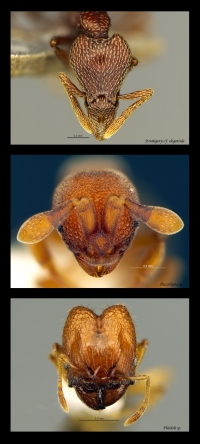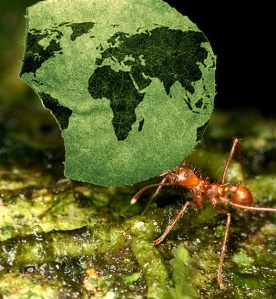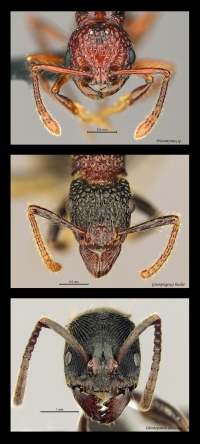Support Biodiversity Discoveries! Help Naming New Ant Species
Discoveries… the geographic and biological exploration of the world has for centuries driven humanity and lead explorers to land foot on remote continents, islands, the highest mountain peaks or to collect the most incredible, largest, or colorful specimens of animals and plants. At the time of Google Maps, where most of the Earth surface is accessible from the same screen you are reading those lines, Humanity is now seeking to explore new planets, comets or the outer bound of our Solar System.
Yet, the vast majority of discoveries remains right here, on this planet. This might come as a surprise to you, but scientists estimate that less than 20% of the species on Earth have been described (about 1.9 million species now described); meaning that several millions of species are still unknown or at the very best have not been named yet by biologists. While you might hear occasionally about a new species of mammals or birds being described, nearly 15,000 of invertebrate species, especially insects are being described every year. This is 40 new species described on average every day, nearly 2 per hour! This might seem fast, but it is in fact very slow, too slow…
While most explorers in the past expected to be the first, modern biologists expect not to be the last… As biodiversity is now highly threaten by our own activities. Deforestation, pollution, climate changes, biological invasions, overharvesting, etc. imperil the millions of species that evolution has slowly formed. Time for action and conservation has come but we must admit that we are unable to estimate accurately the rate of species extinctions even if a recent study1 evaluate to 130,000 species, the number of invertebrate that might have gone extinct over the past decades. This would represent nearly 10% of what we know. At this path, we might be losing species faster than our ability to describe them.
 Why is describing new species important and urgent? It is very simple. To protect or study a species, you need to first name it. A name is not just a label placed on an organism, it is a detailed description of an individual or a group of individuals explaining why and how this species is different from all others. This allows for the next decades or even centuries, anybody patient enough to read this detailed description to recognize this exact same species and then build up more information about it, either about its ecology, distribution, behaviour, or medicinal properties. Naming is the essence of biology. Nowadays for a species, no name means no future. We can not protect what we don’t know, we don’t know what we did not named.
Why is describing new species important and urgent? It is very simple. To protect or study a species, you need to first name it. A name is not just a label placed on an organism, it is a detailed description of an individual or a group of individuals explaining why and how this species is different from all others. This allows for the next decades or even centuries, anybody patient enough to read this detailed description to recognize this exact same species and then build up more information about it, either about its ecology, distribution, behaviour, or medicinal properties. Naming is the essence of biology. Nowadays for a species, no name means no future. We can not protect what we don’t know, we don’t know what we did not named.
In this context, supporting taxonomy (the science of species description) is important more than ever before. Through projects like antmaps.org, we develop new tools that help identifying regions of the world that are most in need of scientific exploration; and by providing individual maps for all of the nearly 16,000 species of ants described, we expect to foster species inventories all over the world. Knowing where biodiversity is will help targeting what to protect and where, not just for ants, but also for millions of other invertebrate species. However, because so much biodiversity is still unknown, we must act to increase the fundamental taxonomic knowledge. Describing new species is thus an important endeavor that we must accomplish sooner than later… all together!
 How can you support biodiversity research?
How can you support biodiversity research?
Here I offer you the possibility to become an actor of biodiversity exploration through a partnership in which you can support Biodiversity & Taxonomy research and scientists working to constantly improve our knowledge and limit biodiversity erosion. In return of your support a new species of ant being described will be named after your choice (see below).
Why naming an ant?
Ants, belong with the other 1.1 million insect species to the most diverse group of organisms on the planet. Among insects, and more broadly within terrestrial arthropods (insects + spiders + centipedes and allies), ants are the dominant group of insects, which biomass (weight) is superior to those of all wild birds and mammals combined2. Not only ants are abundant and ubiquitous, but they are also extremely important for the survival of many species of plants and animals. Did you know that over 11,000 species of plants depend on ants for the dispersal of their seeds, without which they could not have viable populations and would probably go extinct? Ants also bury tons of organic matters, as part of their predacious activities, under ground and participate actively to soil nutrient enrichment, making those nutrients accessible to plants that will use them for their growth. Add to this, the soil turnover they realized while excavating the soil to build their nests, and you have one of the most important ecosystem engineers of most temperate and tropical ecosystems of the world.
I could continue for a long time about the benefits that ants provide to many organisms and ecosystems, but their importance was best summarized by the famous professor from Harvard Edward O. Wilson who simply named them: the little things that run the world!
A species name is composed of two parts. The genus part and the species part. In our own example, Homo sapiens, the name Homo refers to the genus, while sapiens refers to the species. As you might be aware, many other species of the genus Homo, now extinct, have existed (e.g. Homo erectus, Homo neanderthalensis, Homo habilis …). This situation in our genus Homo is rather unusual but not uncommon, in the sense that only one species (Homo sapiens) now survives. In ants, about 340 genera (the plural of genus) are currently recognized with the majority of them including more than one species, some even having more than a thousand species. The genus part will thus be invariant and will be determined by the existing classification of the new species. At the opposite, the new species name is usually chosen by the scientist(s) describing the new species and often refers to some morphological features of the new species (e.g. rufa for red hairs in Latin), or a geographic location (e.g. sinensis when described from China), or to the imagination of the discoverers. For instance some species have recently being named after Mayan gods, or main characters from TVshows or movies. Historically, many species were named after a spouse, a friend or a colleague. Through this project and the great support of patrons, we described two new species, Strumigenys nathistorisoc3 and Strumigenys zanderi4. The first species was named by members of the Hong Kong Natural History Society to honour their association, while the second species was named by a loving mom after the name of her young son who truly enjoys nature.
What about benefactors? What about you?
If you think that supporting research and in particular biodiversity research is important while at the same time would love to dedicate a species named after your spouse, children, grandchildren or grandparents or yourself who has a passion for nature, then support our research.
Choosing a name
You can propose the name you wish, but will have to briefly explain this choice to us for publication. We retain the right to refuse certain names if they are offensive, with political or religious connotations.
Time frame
The whole process of species discovery, description and publication can take several months to several years. This time is necessary to ensure the scientific excellence of the work performed and that the new species described are valid. While enhancing biodiversity knowledge and species description rate represent our main goal, this can not be done at the cost of scientific relevance and quality.
Is it new to donate and have a species named?
No, for the past centuries and the invention of the binomial scientific naming, benefactors have from all time supported scientists to realize explorations or species descriptions. Many famous people have species named after them, such as David Bowie (the Bowie genus in spiders5), Jimmy Page from Led Zeppelin (Stigmatomma pagei6), or Joe Strummer from The Clash (Strumigenys strummeri4). Here we simply propose a more 21st century and open version.
How are the funds being used?
The funds will be used to support taxonomic projects. Those require two main ingredients: trained people and material.
People: Describing species takes time and meticulous work to compare the morphological features with existing species. This work is realized by trained students and experts who like everybody else need to eat. Part of the funds will thus logically support their studies or jobs. For reference, the monthly salary of a student or a Research Assistant in Hong Kong is about 19,000 to 20,000 HK$.
Material: Our laboratory already includes a good set of microscopes that allow us to do sorting, imaging and measurements. Their prices range from 19,000 HK$ to 200,000 HK$ (2,250 Euro to 24,000 Euro). Once in a while some reparation or maintenance might be needed. Other small materials such as forceps, insect pins, ethanol, sorting trays represent our daily consumable/material. While those are relatively cheap individually, their recurrent usage requires to replace/use them regularly.
Specimen storage: The specimens prepared are carefully stored in insect cabinets for their preservation. These cabinets represent an investment, 24,000 HK$ (2,800 Euro), for the safety of the specimens studied, but fortunately represent only occasional purchases.
Postage fees: Exchanging material with other colleagues or museums is important to deposit the newly described specimens or to gain access to previously described species deposited in other museums for direct comparisons. Access to other biological material is key to ensure the validity and uniqueness of the species newly described.
Research and export permits: In order to access a specific place of the world to evaluate the local ant diversity, collect new material and bring it back with us for the entire identification and description processes, we sometimes need to obtain permits. Often, those are not free and we thus need to use some of the funds to pay these fees.
Publication fees: A species is considered scientifically valid only once it is described/published in a scientific journal. Those, however, require scientists to pay to publish their work (imagine that a singer had to pay to have his/her songs played on the radio) and those costs can be quite substantial (rates vary among journals but the average per article would range from 2600 HK$ [300 Euro] to 12.000 HK$ [1,400 Euro]). As this is one of the most important and final steps in the process, funds will be managed to allow final publication.
What is the appropriate donation?
As presented above, a certain number of expenses arise while describing species. As a consequence, a threshold of 30,000 HK$ [~3,600 Euro] is requested per species. The donation will only be used to conduct scientific research. Naturally, higher (and generous) donations are very welcome as those will be used for the training of students, the development of new surveys in different parts of the world or the development of more ambitious taxonomic revision projects.
To know more about this project, do not hesitate to contact me by e-mail: bguenard@hku.hk
For groups of people, I can also provide presentations to introduce the importance of ants in ecosystems and the important task ahead of us.
References
1- Régnier C., G. Achaz, A. Lambert, R. H. Cowle, P. Bouchet, and B. Fontaine (2015) Mass extinction in poorly known taxa. Proceedings of the National Academy of Sciences USA, 112, 7761-7766.
2- Schultheiss P., S. Nooten, R. Wang, M.K.L. Wong, F. Brassard, & B. Guénard. The abundance, biomass and distribution of ants on Earth. Proceedings of the National Academy of Sciences 119(40), e2201550119.
3- Tang K.L., M.P. Pierce, & B. Guénard. 2019. Review of the genus Strumigenys (Hymenoptera, Formicidae, Myrmicinae) in Hong Kong with the description of three new species and the addition of five native and four introduced species records. Zookeys 831, 1–48.
4- Tang K.L. & B. Guénard. 2023. Further additions to the knowledge of Strumigenys (Formicidae: Myrmicinae) within South East Asia, with the description of 20 species. European Journal of Taxonomy 907(1), 1-144.
5- Jager P. 2022. Bowie gen. nov., a diverse lineage of ground-dwelling spiders occurring from the Himalayas to Papua New Guinea and northern Australia (Araneae: Ctenidae: Cteninae). Zootaxa 5170(1): 1-200.
6- Hamer M, MP Pierce, & B Guénard. 2023. The Amblyoponinae (Formicidae) of Hong Kong. Asian Myrmecology 16, 016005: 1-37.

